Formerly known in some circles as Angraecum citratum, Aerangis citrata is found throughout Madagascar. From the southeast coast through the central part of the country into the northwest section. It is an epiphyte growing on lower branches that can be found at sea level to about 4,900 feet (1,500m). It is almost always found near water of some sort and is highly adaptable in several types of climate as long as the moisture is available.
Aerangis citrata is a very easy plant to grow. It is often sought after by collectors that prefer mini or small species because it will grow and thrive under lights. A decent specimen plant will bloom 2 - 3 times during the year and will produce numerous inflorescence with as many as 15 - 20 flowers.

As with all of my Aerangis that I grow, Aergs. citrata is grown mounted to cork slabs. I prefer the plants to be slightly pendant so that any excess water does not sit in the leaves against the stem. The water runs off of the plants easily. This also allows the inflorescence to freely become pendant and the flowers can be seen at just about any angle.
During the warm late spring, the hot summer and into early fall, the mounted Aerangis' are watered every day. When temperatures reach the mid eighties and into the nineties, the plants are also misted heavily in the afternoon hours. Giving them enough time to dry off prior to night fall.
When temperatures do cool down into the low seventies and lower; the watering frequency is cut back to just misting in the morning and regular watering every three days. It is important to mist the mounted plants throughout the warmer days because the plant can dehydrate without enough moisture.
As stated earlier, the plants are highly adaptable and can handle the warm summer days and cooler temps of fall and winter. For plants that are grown in the hobbyists' home in colder regions; be sure to keep them away from direct contact of windows where temperatures can be 10 - 15 degrees F (6-9C) cooler than a spot on a table just a few feet away.
The amount of light that my plants receive is no brighter than bright shade and have been placed in areas for short periods of time that is less than average Phal light. Aerangis citrata should not get any direct sun light. The leaves are broad and thin enough that they will burn easily and dehydrate the plant itself. It will do well in average Phal light.
For those of you that are growing Aerangis citrata in small pots; be sure that the mix you're using drains and no excess water sits in the pot. Although the plant requires and thrives on that moisture, you do not want the roots to rot. The stem's average height is about 2.4 inches (6cm) and will hold 6 - 8 leaves that are 3 - 4.7 inches (8-12cm) long by 1 - 1.5 inches (2.5-4cm) wide. It will do very well in a 3 - 4 inch (8-10cm) pot and should not out grow it. If the medium that you are using does start to break down, re-pot the plant at the beginning of the growing season (early spring) so that the plant does re-establish itself quickly.
I use a standard fertilizer once a week throughout the entire spring, summer and early fall. Once the watering is backed off, I eliminate the fertilizer until spring or when the new growth begins. A systemic fungicide is applied every three to four weeks and I keep a watch for small issues due to the amount of water given to the plants. Insecticides and mite-icides are applied every 6 - 8 weeks and a small amount is kept on hand in case there are any problems. Here in South Florida, spider mites can creep up suddenly as well as white fly problems (which have become a big nuisance in the last year or so). Watch for scale on the inflorescence as they develop.
During the blooming periods, inflorescence will grow from the leaf axils. Each can be up to 10 inches (25cm) long and carry up to 18 flowers. Buds will form along the entire length of the flower spike about .4 inches (1-1.3cm) apart and will always face in one direction. Flowers are .6 - .7 inches (1.5-1.7cm) wide by .7 - .8 inches (1.7-2.0cm) high. Each flower has a club shaped nectary or spur that is about 1.2 inches (3cm) long. It is usually green from the throat of the flower turning a pristine white at the last quarter length of the tip.
 Developing buds & flowers of Aerangis citrata
Developing buds & flowers of Aerangis citrata
Once the inflorescence has grown and the buds begin to develop, they all develop upright. The short nectary will already be in position and that is facing down or dropping down. The flowers will open successively. Those being closest to the plant opening first and then towards the tip. It is said that the flowers have a faint citrus fragrance, although I have never picked up on that.
Aerangis citrata will become a beautiful specimen plant in 3 - 5 years after it's first blooms appear. Be sure to give it the proper care and meet its requirements and the plant will bless you with numerous flowers a few times a year.
